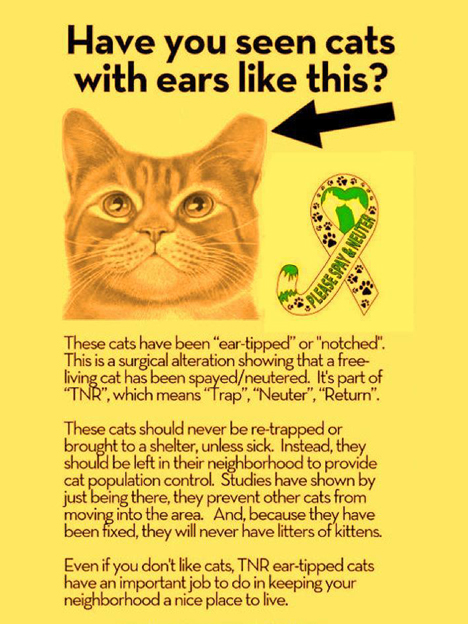
Frequently Asked Questions
A community cat is also known as a feral (wild) cat or a stray, lost or abandoned pet cat that has reverted to feral behavior and joined a “colony”. These cats are in every neighborhood, business park, or community. These exist through no fault of their own but because of the irresponsibility of people in not spaying or neutering or letting their pet cat outside to roam and get lost. They deserve to live and need the “community” to help them. By getting them all spayed/neutered/vaccinated with a program called, “TNR” (Trap/Neuter/Return), the reproducing stops. Fighting, inbreeding, spraying, and other bad behavior diminishes. Most TNR’d cats then become part of a “managed” feral colony. They are fed and watered daily by one or more caretakers, provided shelter if allowed, and monitored for sickness and injury. They can live long and healthy lives when handled in this manner. It is the ONLY humane solution for these cats. A managed colony, also keeps newcomers away in most cases, keeping the numbers intact and eventually letting the colony become non-existent. For more information visit: https://www.alleycat.org
The clipped ear or “ear-tip” is a sign that the cat has been TNR’d (trapped/neutered/returned). He or she is spayed or neutered and vaccinated. Most likely this cat is being cared for by a caretaker. But rest assured, it is not out there reproducing nor getting into fights or spraying.
First of all, these are not adoptable cats 99% of the time and they do not belong in a shelter. Secondly, there is no “magical fairy land” for them to go. There are such things as barn placements, but most of these cats are city cats and are not accustomed to surviving in the country and most barn placements are not done correctly, putting the cats in even more danger. If not properly held up for 2-4 weeks in a large shed , barn or building, they will disappear when the doors are opened for them and many get killed trying to return to their original “home”. They cannot simply be trapped and put into other colonies either unless there is a way to properly keep them contained to acclimate to the new location for preferably a month. Animal Control will rarely come out to trap cats and most cities are on board with the Trap/Neuter/Return program as a solution, as it saves taxpayer dollars by having volunteer trappers trap and alter the cats, preventing them from using the city or county shelter resources, and by not having to respond to calls by the Animal Control. And they advocate a more humane solution for these cats. Plus if you remove ALL Cats in the area, new ones will just move in within a short time and start the reproduction all over again and why it is much better to have an existing “managed” colony where all are fixed and maintained. Even if you removed all of the food, the cats would still stay…it is the only home they know. Read more bout the “Vacuum Effect” HERE These cats exist in the only home they know. They should be allowed to live out their lives in this “home”. There are many advantages to TNR’ing them. They will help keep spiders, rodents, and snakes away from your home/office. They will keep unaltered newcomer cats at bay. Even people who are not “cat” people, end up enjoying caring for them. We call it “loving them from afar”. Many cats over time, will become tame with the caretaker only and some become tame in general. At that point, they could become someone’s pet, or simply remain a friendly backyard or office cat. For more information visit: https://www.alleycat.org
In most cases, leave them be! Feral mom cats are very leery of people and on guard. They do NOT want you to know where they keep their babies, so oftentimes, if people are around, they will leave the kittens until it is safe to return. Many times, if they sense danger or are moving them closer to the feeding station (they are often moved 2-3 times, each time closer and closer to the source of food). Many folks will feed stray cats and as the kittens get old enough to eat, she moves them closer to that station. It is when the kittens are at that age, that you want to try to help them. Only intervene if you know for a fact that the mother has been killed or has not been taking care of them for several hours.
Most shelters are not staffed properly to accommodate bottle feeding and it is an around the clock schedule to keep them alive. Many bottle-fed babies do not survive for many reasons. They need mom’s milk to obtain the proper antibodies to fight illness. The first three weeks of mom’s milk, is vital to their survival and allows them to thrive. It is almost always best to let mom do her job. Also, she spends a great deal of time prepping and finding safe spots for her kittens. When people try to intervene and “look to find the kittens”, she looks at that as a warning sign and will move them. Each time she has to move them, may decrease the safety of the area. Also in larger colonies of cats where there are more than one mother cat nursing, the other mothers will oftentimes take over the care, if something has happened to the original mom.
If you know for sure the kittens are not being taken care of, do not attempt to tackle the bottle feeding on your own, unless you are very experienced. This link can help you identify the ages of the kittens too, which will help you determine the best outcome for them. How to Determine a Kitten’s Age | Alley Cat Allies You can also contact your local shelter, or take them up to the shelter and let them find the resources to help them. But again, you must be certain, human intervention is necessary. No one does a better job than mom!
For more information visit: https://www.alleycat.org.
Do not intervene! Do not try to look for the kittens (this only puts stress on the mom to find another place to move them to and she will move them if you let her know you know where they are!). Provide plenty of fresh water and kitten food for the mom and preferably not close to where you think she may be hiding the kittens. Example: Most likely place is underbrush or a shed, deck or other structure. Set the food and water on your back porch several feet away from the nesting area. When the kittens are old enough to start eating on their own, she will bring them to the feeding station. At that age is when you want to get them so that they have a good chance of taming down and getting adopted.
However, we always recommend trapping the mom FIRST, then the kittens. If she sees you take the kittens, she will be very hard to trap. She will not trust you or the trap. Also, once the kittens are removed (the most COMMON MISTAKE people make), she is now no longer nursing and can go into heat as soon as two weeks! This is not healthy for the moms and only brings more unwanted kittens into the world. Trap mom first, and you end the cycle. Kittens are easy to trap and can be done so quickly, so they can be brought into safety. If you have any doubts or questions, always contact us first before acting. We will mentor you through the process.
For more information visit: https://www.alleycat.org.
Not everyone in the neighborhood will be cat people or be pro TNR or keeping them around. We recommend you form alliances with the cat-friendly people. Have one or two “leaders” be willing to get properly trained and mentored and head up the project. We always recommend trapping where the feeding station is and to feed DISCREETLY for the protection and safety of the cats and to not draw attention to the process or feeding. Many people get angry when they know you feed stray cats. In their mind, you are contributing to the overpopulation. We also have a slogan "IF YOU FEED, YOU MUST FIX". It is not responsible to feed feral or stray cats and not get them TNR’d. Contact us if you are interested in becoming a "Neighborhood TNR Leader".
What We Will Do:
We will loan out traps and train you on the trapping process. We will mentor you throughout the process. We will provide you with a cheat sheet for easy instructions.
We can sometimes assist in the trapping, if we have someone available, for disabled or elderly people. Same with taking them into the feral cat clinic.
We will recover injured or sick cats, or ones that need longer than the typical day or two.
Train anyone that wants to become a TNR Neighborhood Leader.
What We will NOT Do:
Trap and remove cats.
Loan out traps if instructions are not properly followed. (There are safety procedures to ensure cats are not harmed in the process.
Take to the clinic and recover in most cases.
DO:
Always have a plan! Never just set out to trap a cat unless a plan is in place for the cat to go to the clinic the next day.
Always line the trap with cardboard before baiting it. (cut it a little less than the width of the trap and have it long enough to go from the entrance all the way to the end of the PLATE of the trap (not the end of the trap).
Use Tuna fish in oil preferably, sardines, fried chicken (not with bone-pull off the meat).
Have an old sheet for covering the trap after the cat goes in. Cut it to where there a slit on top for the handle and so it covers the entire trap. A darker sheet is best. This will totally calm the cat once he goes in. (VERY important).
Know your cats. Which ones just had kittens, whose kittens are whose, when were they born, etc. This will be important when knowing who to trap first.
DON’T:
Ever leave a trap unattended for long periods. You want to know when they go in so they can be covered immediately and “removed from the scene” especially when trapping several cats. A cat banging around in a trap will scare off all cats and ruin chances of trapping the others, even if it’s on another day, even weeks later. But most importantly, predators can approach the trap and if they are trapped they can break their neck or tail trying to get out.
Ever leave the trap out overnight – same reasons as above. You may use a monitor so that you are alarmed when the cat or other animal goes in and can quickly go to the scene but we recommend trapping at the normal feeding time and setting up a feeding station prior to trapping.
Never trap or take kittens away first! Mom will be extremely hard to trap and this puts her going into heat potentially in two weeks. We will discuss this more with you during the mentoring process.
Put the trap on grass or unsteady ground. The trap can flip and the cat can escape, ruining the chances of successfully trapping that cat again.
Travel with a cat in a trap in the bed of a pickup! This is very dangerous to the well-being of the cat and is extremely stressful. Always covered, kept in a dark quiet place until traveling to the clinic and on a lined area in the backseat, back end of the car. INSIDE only.
Note: There are many other tips and scenarios which is why we like to mentor you through the process. If instructions are followed, you can successfully trap all cats in a little time, and then your job is done. Then you will have a managed colony.
We accept donations for the time spent on assisting with the process. The feral cat clinics charge anywhere between $20 - $80 per cat, depending on the clinic used. We can sometimes assist with this expense and do what we can to keep the cost minimal. If a neighborhood group has been formed, they can take up a collection to cover costs.
We generally get the Rabies Vaccination and the FVRCP Vaccination. No testing is done unless the cat is very ill. Even if the cats were exposed to Feline Aids or Leukemia, the consensus is, all cats in the colony have been living together and the caretaker (feeder) observes for illness at which time, intervention may be necessary. The cats deserve to live out their lives and most people trapping cannot afford to test each and every cat. For more information, read what Alley Cat Allies says: https://www.alleycat.org/resources/protocols-testing-feline-immunodeficiency-virus-fiv-and-feline-leukemia-virus-felv/
SIGN UP FOR OUR NEWSLETTER
Please sign up for our newsletter for cat-related tips and tricks and to get updates on our cats and events!





